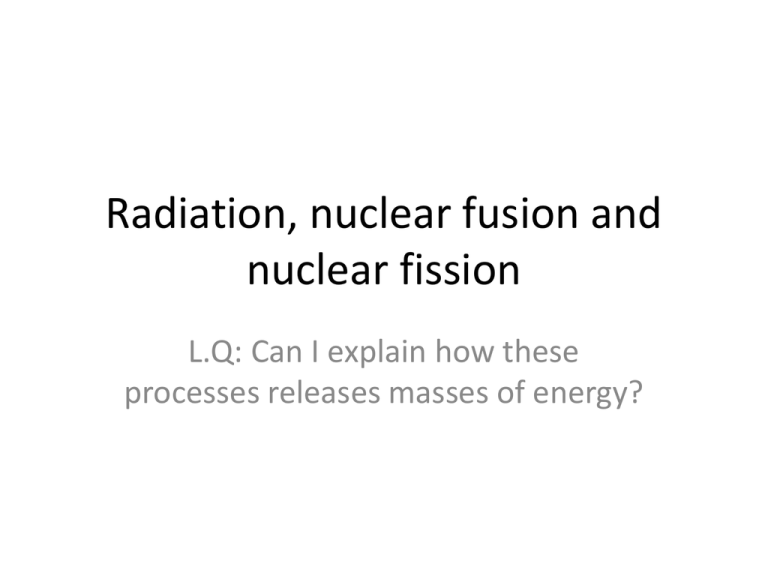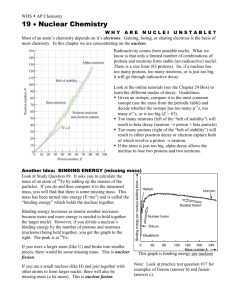Nuclear fission and fusion
advertisement

Radiation, nuclear fusion and nuclear fission L.Q: Can I explain how these processes releases masses of energy? What you need to know The atom Draw a labelled diagram of the atom showing the nucleus and labelling protons, neutrons and electrons. nucleus neutron electron proton Where are subatomic particles found? Protons, neutrons and electrons are NOT evenly distributed in an atom. The protons and neutrons exist in a dense core at the centre of the atom. This is called the nucleus. The electrons are spread out around the edge of the atom. They orbit the nucleus in layers called shells. What we used to think… It was believed that atoms were: 1. Spheres of positive charge. 2. With negative charges spread through it. This resembled a plum-pudding, so it was called the ‘Plum –pudding’ model. This was wrong! How did we discover current ideas about the structure of the atom? Rutherford’s team: Ernest Rutherford and his team of scientists performed a famous experiment in Manchester: They fired some alpha particles at a piece of thin gold foil (only a few atoms thick): If the ‘Plum Pudding’ model of the atom was correct, the alpha particles should pass straight through and only be slightly deflected. This did not happen. What Rutherford’s team observed…….. 1. Most of the alpha particles went straight through the foil. 2. Some alpha particles were deflected through large angles. 3. A very few alpha particles were reflected straight back. Rutherford’s conclusions Observation Most alpha particles went straight through the foil. A few were deflected through large angles. A very few were reflected straight back. Conclusion Atoms are mostly space. The nucleus is very small compared to the size of the atom and it contains most of the mass and all the positive charge. Does the nucleus make sense? • How are all those protons held together when they have the same charge? • Strong force between protons and neutrons that is stronger than the electrostatic repulsion between protons • Hold protons and neutrons together in a dense core nucleus • Called the strong force Calculate the number of protons, electrons and neutrons shown below - 12 13 C 6 14 C 6 C 6 Thesehave They are all different theisotopes atoms element numbers of that the carbon, of same neutrons. what element is the with difference different between numbers them? of What do we call are unstable and emit radiation to become more Isotopes Radioisotopes neutrons? stable? Isotope • Element that exists in different forms – isotopes have the same atomic number but different mass numbers • Different number of neutrons • Isotopes unstable – give off radiation Radiation • Form of energy given off by unstable nuclei • Ionising • Atoms that give off radiation are said to be radioactive • Most objects give off some type of radiation – even us!! • Energy is released and some mass is lost from the release of a particle • So the nuclei becomes a new element Background radiation Background radiation is the radiation all around us. Rocks Air Building materials Outer space Food Physical and chemical processes • These do not change radioactivity of a sample • E.g. Freezing a sample or reacting it with another chemical cannot change radioactivity Why are some substances radioactive? • Radioactive atoms have an unstable nucleus • It becomes stable by losing a particle • This is known as radioactive decay Types of radiation • • • • What is emitted by the nucleus? Alpha radiation (particle) Beta radiation (particle) Gamma radiation (EM wave) Type of decay: Alpha decay What is emitted? Alpha particle (helium nuclei) Description of decay: Example of decay: Effect on M and A: 2 neutrons and 2 protons are emitted from the nucleus. 238 92 U 234 4 90 2 Th + + energy M decreases by 4, A decreases by 2 (M-4, A-2) Type of decay: Beta decay What is emitted? High energy electron Description of decay: Example of decay: Effect on M and A: A neutron in the nucleus decays into a proton and a high energy electron which is emitted. 14 C 6 14 0 N + + energy 7 -1 M stays the same, A increases by 1 (M=, A+1) Type of decay: Gamma decay What is emitted? High energy electromagnetic radiation. Description of decay: Nucleus changes shape into a more stable shape. Gamma radiation emitted as a result. Effect on A and Z: A stays the same, Z stays the same (A=, Z=) The penetration power of the three types of radiation. Thin mica Skin or paper stops ALPHA Thin aluminium stops BETA Thick lead reduces GAMMA STRONG FORCE!! • Electrostatic forces between protons cause them to be repelled....but.... • A stronger force keeps the protons and neutrons concentrated in the nucleus • This is a called the strong force • This force only works when the protons and neutrons are very close together. • If they move too far apart the strong force disappears Nuclear fuel • Fuel which releases energy through changes in the nucleus • The energy released from a nuclear material is much greater than a chemical reaction containing a similar mass of material Nuclear fusion • Two nuclei collide • Two nuclei fuse to form a larger nuclei, releasing lots of energy • Two H nuclei form He • Must get close enough to overcome the repulsion of electrostatic attraction • And allow the strong force to hold them together • Need energy for that – carried out at high temperatures/pressure E = mc2 • • • • • Mass can be converted into energy E = energy M = mass C = speed of light in a vacuum (3x108 m/s) Mass is lost when fission/fusion occurs Nuclear Power - fission When a nucleus decays it gives out heat energy. In a nuclear power station, the uranium-235 atoms decay and give out energy and neutrons. Each time a uranium atom splits it produces 2 or 3 neutrons (depending on the reaction). These go on to hit other uranium atoms, which causes them to decay. A chain reaction is set up where more and more energy is released. In a nuclear reactor the process is carefully controlled so that neutrons are absorbed harmlessly and the energy released is controlled. In a nuclear bomb the reaction is not controlled, and the bomb explodes! Nuclear fission • Uranium/plutonium • Neutron splits a large and unstable nucleus into two smaller parts, roughly equal in size • This will release more neutrons and cause more neighbouring nuclei to break down • Generates an uncontrolled chain reaction of nuclear fission • In nuclear power stations the reaction is controlled • Neutron release is controlled so reaction occurs at a controlled pace • If not could cause a nuclear explosion Nuclear Power - fission Fast neutron from previous decay cause the Uranium nucleus to split. Nuclear Power Kr n More n n Uranium n In the reaction above a neutron from a previous decay can lead to more and more decays. This is called a chain reaction. Ba decays How is this controlled • Uranium is very radioactive and therefore the fission reaction needs to be controlled to prevent an explosion • Nuclear fission of uranium occurs when the nucleus absorbs a neutron • The nucleus splits into two smaller nuclei and releases some neutrons • Each of these neutrons can then be absorbed by another uranium nucleus • This is an example of a chain reaction where each fission causes more fissions to occur • Each fission releases lots of energy • Fuel rods become very hot so can heat coolant which then turns into steam which turn turbines • Control rods containing Boron are put in between the uranium rods, to absorb some of the neutrons • This keeps the rate of nuclear fission constant • So there is a steady release of energy, not uncontrolled • Coolant is used to take away the heat produced by nuclear fission Nuclear fission • • • • • • Splitting of an atom called “chain reaction” (controlled) A slow moving neutron gets absorbed by uranium (U-235) or plutonium (Pu - 239 When one atom of U-235 splits 2 or 3 neutrons are given off Each neutron goes on to split another 3 atoms, so another 9 neutrons are released, then 27 etc If there isn’t a large enough amount of U-235 no reaction will occur The minimum amount of uranium needed is called the critical mass Fission vs fusion • • • • • • • • • Fission: Nucleus absorbs neutron Unstable Splits large nucleus into smaller nuclei Releases more neutrons That split more large nuclei Starts a chain reaction Uranium/plutonium Mass lost as energy (E=mc2) • • • • • • • • Fusion: Small nuclei collide High temp/pressure Two nuclei fuse together Larger nuclei formed E.g. Hydrogen – helium Mass lost as energy (E=mc2) More energy released compared with fission








